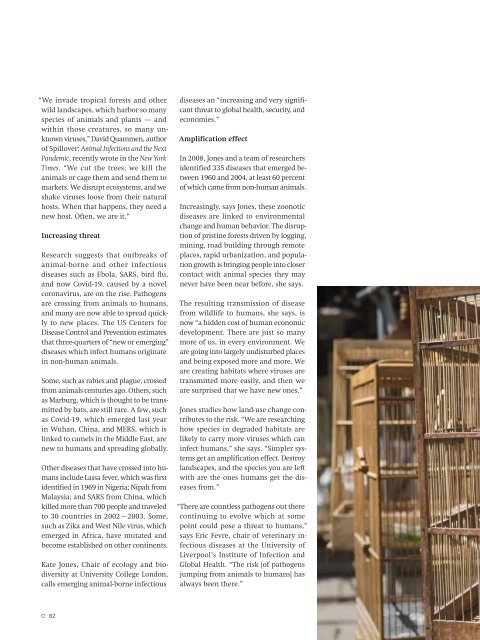Planet under Pressure
The 2020s are the make-or-break decade for Sustainability. But Covid-19 questions almost everything. How can we handle increasingly frequent shocks? What can a resilient society and economy that is in line with planetary boundaries look like? These and many other questions are discussed in the new 2020 edition of the Global Goals Yearbook titled “Planet under Pressure”. The Yearbook supports the UN Sustainable Development Goals and is one of the publications in strong international demand.
The 2020s are the make-or-break decade for Sustainability. But Covid-19 questions almost everything. How can we handle increasingly frequent shocks? What can a resilient society and economy that is in line with planetary boundaries look like? These and many other questions are discussed in the new 2020 edition of the Global Goals Yearbook titled “Planet under Pressure”. The Yearbook supports the UN Sustainable Development Goals and is one of the publications in strong international demand.
Create successful ePaper yourself
Turn your PDF publications into a flip-book with our unique Google optimized e-Paper software.
“We invade tropical forests and other<br />
wild landscapes, which harbor so many<br />
species of animals and plants — and<br />
within those creatures, so many unknown<br />
viruses,” David Quammen, author<br />
of Spillover: Animal Infections and the Next<br />
Pandemic, recently wrote in the New York<br />
Times. “We cut the trees; we kill the<br />
animals or cage them and send them to<br />
markets. We disrupt ecosystems, and we<br />
shake viruses loose from their natural<br />
hosts. When that happens, they need a<br />
new host. Often, we are it.”<br />
Increasing threat<br />
Research suggests that outbreaks of<br />
animal-borne and other infectious<br />
diseases such as Ebola, SARS, bird flu,<br />
and now Covid-19, caused by a novel<br />
coronavirus, are on the rise. Pathogens<br />
are crossing from animals to humans,<br />
and many are now able to spread quickly<br />
to new places. The US Centers for<br />
Disease Control and Prevention estimates<br />
that three-quarters of “new or emerging”<br />
diseases which infect humans originate<br />
in non-human animals.<br />
Some, such as rabies and plague, crossed<br />
from animals centuries ago. Others, such<br />
as Marburg, which is thought to be transmitted<br />
by bats, are still rare. A few, such<br />
as Covid-19, which emerged last year<br />
in Wuhan, China, and MERS, which is<br />
linked to camels in the Middle East, are<br />
new to humans and spreading globally.<br />
Other diseases that have crossed into humans<br />
include Lassa fever, which was first<br />
identified in 1969 in Nigeria; Nipah from<br />
Malaysia; and SARS from China, which<br />
killed more than 700 people and traveled<br />
to 30 countries in 2002–2003. Some,<br />
such as Zika and West Nile virus, which<br />
emerged in Africa, have mutated and<br />
become established on other continents.<br />
Kate Jones, Chair of ecology and biodiversity<br />
at University College London,<br />
calls emerging animal-borne infectious<br />
diseases an “increasing and very significant<br />
threat to global health, security, and<br />
economies.”<br />
Amplification effect<br />
In 2008, Jones and a team of researchers<br />
identified 335 diseases that emerged between<br />
1960 and 2004, at least 60 percent<br />
of which came from non-human animals.<br />
Increasingly, says Jones, these zoonotic<br />
diseases are linked to environmental<br />
change and human behavior. The disruption<br />
of pristine forests driven by logging,<br />
mining, road building through remote<br />
places, rapid urbanization, and population<br />
growth is bringing people into closer<br />
contact with animal species they may<br />
never have been near before, she says.<br />
The resulting transmission of disease<br />
from wildlife to humans, she says, is<br />
now “a hidden cost of human economic<br />
development. There are just so many<br />
more of us, in every environment. We<br />
are going into largely undisturbed places<br />
and being exposed more and more. We<br />
are creating habitats where viruses are<br />
transmitted more easily, and then we<br />
are surprised that we have new ones.”<br />
Jones studies how land-use change contributes<br />
to the risk. “We are researching<br />
how species in degraded habitats are<br />
likely to carry more viruses which can<br />
infect humans,” she says. “Simpler systems<br />
get an amplification effect. Destroy<br />
landscapes, and the species you are left<br />
with are the ones humans get the diseases<br />
from.”<br />
“There are countless pathogens out there<br />
continuing to evolve which at some<br />
point could pose a threat to humans,”<br />
says Eric Fevre, chair of veterinary infectious<br />
diseases at the University of<br />
Liverpool’s Institute of Infection and<br />
Global Health. “The risk [of pathogens<br />
jumping from animals to humans] has<br />
always been there.”<br />
62 Global Goals Yearbook 2020
















